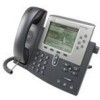Cisco 7962G Administration Guide - Page 160
The SW Port Configuration option in the Network Configuration menu on, Unified Communications Manager - work without callmanager
 |
UPC - 882658140341
View all Cisco 7962G manuals
Add to My Manuals
Save this manual to your list of manuals |
Page 160 highlights
General Troubleshooting Tips Chapter 9 Troubleshooting and Maintenance Table 9-2 Cisco Unified IP Phone Troubleshooting (continued) Summary Loopback condition. One-way audio. Peer Firmware Sharing fails. Cisco VT Advantage/Unified Video Advantage (CVTA) Phone call cannot be established Explanation A loopback condition can occur when the following conditions are met: • The SW Port Configuration option in the Network Configuration menu on the phone is set to 10 Half (10-BaseT / half duplex) • The phone receives power from an external power supply • The phone is powered down (the power supply is disconnected) In this case, the switch port on the phone can become disabled and the following message will appear in the switch console log: HALF_DUX_COLLISION_EXCEED_THRESHOLD To resolve this problem, re-enable the port from the switch. When at least one person in a call does not receive audio, IP connectivity between phones is not established. Check the configurations in routers and switches to ensure that IP connectivity is properly configured. If the Peer Firmware Sharing fails, the phone will default to using the TFTP server to download firmware. Access the log messages stored on the remote logging machine to help debug the Peer Firmware Sharing feature. Note These log messages are different than the log messages sent to the phone log. If you are having problems getting CVTA to work, make sure that the PC Port is enabled, and that CDP is enabled on the PC port. See Network Configuration Menu, page 4-5 for more information. The phone does not have a DHCP IP address, is unable to register to Cisco Unified Communications Manager, and shows a Configuring IP or Registering message. Verify the following: 1. The Ethernet cable is attached. 2. The Cisco CallManager service is running on the Cisco Unified Communications Manager server. 3. Both phones are registered to the same Cisco Unified Communications Manager. 4. Audio server debug and capture logs are enabled for both phones. If needed, enable Java debug. 9-12 Cisco Unified IP Phone 7962G and 7942G Administration Guide for Cisco Unified Communications Manager 6.1 OL-14625-01















